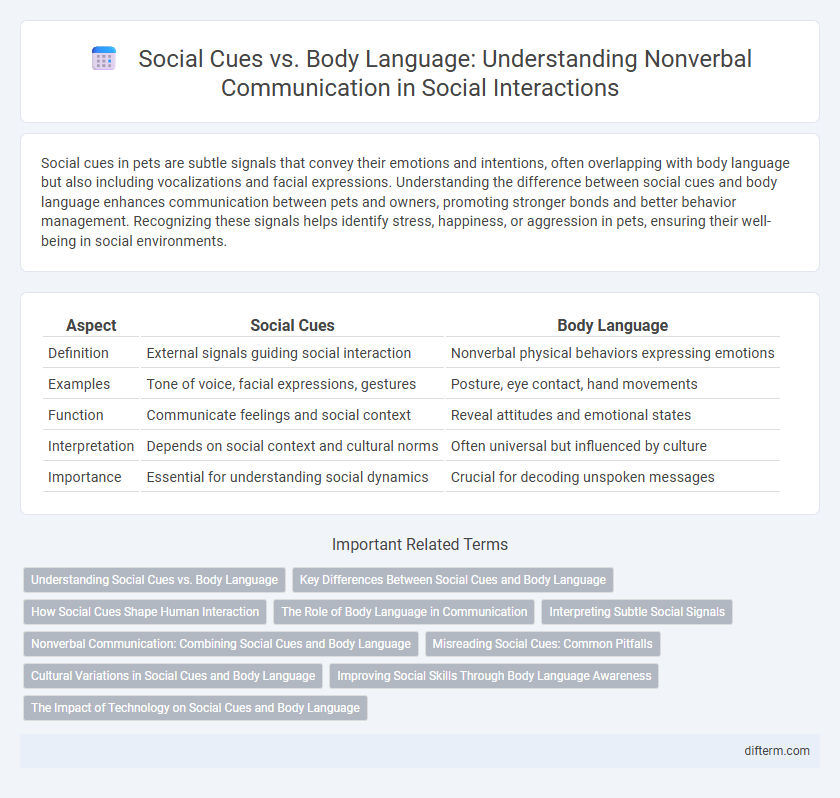Social cues in pets are subtle signals that convey their emotions and intentions, often overlapping with body language but also including vocalizations and facial expressions. Understanding the difference between social cues and body language enhances communication between pets and owners, promoting stronger bonds and better behavior management. Recognizing these signals helps identify stress, happiness, or aggression in pets, ensuring their well-being in social environments.
Table of Comparison
| Aspect | Social Cues | Body Language |
|---|---|---|
| Definition | External signals guiding social interaction | Nonverbal physical behaviors expressing emotions |
| Examples | Tone of voice, facial expressions, gestures | Posture, eye contact, hand movements |
| Function | Communicate feelings and social context | Reveal attitudes and emotional states |
| Interpretation | Depends on social context and cultural norms | Often universal but influenced by culture |
| Importance | Essential for understanding social dynamics | Crucial for decoding unspoken messages |
Understanding Social Cues vs. Body Language
Social cues encompass a broad range of verbal and non-verbal signals, including tone of voice, facial expressions, gestures, and proxemics, which guide interpersonal interactions and communication. Body language specifically refers to the non-verbal physical gestures, posture, and movements that express emotions and intentions, often complementing or contradicting spoken words. Understanding the distinction between social cues and body language is essential for accurately interpreting underlying feelings and improving social awareness in both personal and professional settings.
Key Differences Between Social Cues and Body Language
Social cues encompass a broader range of nonverbal signals, including facial expressions, tone of voice, and proxemics, whereas body language specifically refers to gestures, posture, and movement. Social cues integrate contextual information from the environment and cultural norms, influencing how messages are interpreted during interactions. Understanding the distinction aids in improving communication effectiveness and social awareness in diverse settings.
How Social Cues Shape Human Interaction
Social cues, including tone of voice, facial expressions, and gestures, play a vital role in shaping human interaction by providing context beyond verbal communication. Body language, a subset of social cues, reveals unspoken emotions and intentions, influencing trust and empathy between individuals. Effective interpretation of these nonverbal signals enhances social bonding and facilitates smoother interpersonal connections.
The Role of Body Language in Communication
Body language plays a critical role in communication by conveying emotions and intentions beyond spoken words, including facial expressions, gestures, and posture. Understanding these nonverbal signals enhances social interactions by providing context and reinforcing verbal messages. Misinterpretation of body language can lead to misunderstandings, emphasizing the need for accurate reading of social cues in effective communication.
Interpreting Subtle Social Signals
Interpreting subtle social cues requires sensitivity to both verbal tone and nuanced body language, such as microexpressions and small gestures that convey emotions beyond words. These subtle signals often provide critical context for understanding intent and feelings in social interactions, enabling more accurate communication and empathy. Mastery of recognizing these complex social signals enhances interpersonal relationships by fostering deeper connection and trust.
Nonverbal Communication: Combining Social Cues and Body Language
Nonverbal communication integrates social cues and body language to convey emotions and intentions effectively. Facial expressions, gestures, posture, and eye contact function as critical social cues that enhance interpersonal understanding without spoken words. Mastery of these elements improves social interactions by decoding unspoken messages and fostering empathetic connections.
Misreading Social Cues: Common Pitfalls
Misreading social cues often leads to misunderstandings in interpersonal interactions, as individuals may confuse subtle expressions like microexpressions or tone of voice with body language signals such as posture or gestures. People frequently mistake nervous habits, like fidgeting, for dishonesty or disinterest, which can skew the overall interpretation of social intent. Awareness of these common pitfalls enhances emotional intelligence and improves communication effectiveness.
Cultural Variations in Social Cues and Body Language
Cultural variations in social cues and body language significantly influence interpersonal communication, as gestures, facial expressions, and eye contact carry different meanings across societies. For example, direct eye contact is seen as confidence in Western cultures, whereas in some Asian cultures, it may be perceived as disrespectful or confrontational. Understanding these cultural differences is essential for effective cross-cultural interactions and avoiding misinterpretations in social settings.
Improving Social Skills Through Body Language Awareness
Understanding social cues through body language enhances interpersonal communication by revealing unspoken emotions and intentions. Developing awareness of gestures, facial expressions, and posture fosters better empathy and rapport in social interactions. Mastery of body language signals improves confidence and facilitates smoother conversations in diverse social settings.
The Impact of Technology on Social Cues and Body Language
Technology has significantly altered the interpretation and expression of social cues and body language, as digital communication often lacks physical gestures and facial expressions essential for conveying emotions. Video calls and social media platforms partially bridge this gap, yet they frequently lead to misinterpretations due to limited nonverbal signals. The reliance on text-based communication reshapes social interactions, emphasizing emojis and acronyms as new forms of body language in virtual environments.
social cues vs body language Infographic

 difterm.com
difterm.com